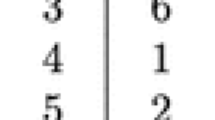Abstract
Strategy-proof, budget-balanced, and envy-free rank mechanisms assign q identical objects to n agents. The efficiency loss is the largest ratio of surplus loss to efficient surplus, over all profiles of non-zero valuations. The smallest efficiency loss \(\frac{n-q}{n^{2}-n}\) is uniquely achieved by the following simple allocation rule: assign one object to each of the \(q-1\) agents with the highest valuations, a large probability to the agent with the qth highest valuation, and the remaining probability to the agent with the \((q+1)\)th highest valuation.
Similar content being viewed by others
Notes
Worst case analysis has been applied to various settings, see the introduction of Moulin (2009) for a brief survey.
The author thanks the referee who pointed out this interesting result.
References
Cavallo R (2006) Optimal decision-making with minimal waste: strategyproof redistribution of VCG payments. In: Proceedings of the fifth international joint conference on Autonomous agents and multiagent systems (AAMAS) Hakodate, Japan, May 08–12, 2006,
Cramton P, Gibbons R, Klemperer P (1987) Dissolving a partnership efficiently. Econometrica 55(3):615–632. ISSN 0012-9682. https://doi.org/10.2307/1913602. http://www.jstor.org/stable/1913602
Drexl M, Kleiner A (2015) Optimal private good allocation: the case for a balanced budget. Games Econ Behav 94:169–181
Green JR, Laffont J-J (1979) Incentives in public decision-making. Elsevier Science Ltd, Amsterdam
Guo M, Conitzer V (2009) Worst-case optimal redistribution of VCG payments in multi-unit auctions. Games Econ Behav 67(1):69–98
Guo M, Conitzer V (2014) Better redistribution with inefficient allocation in multi-unit auctions. Artif Intell 216:287–308
Long Y, Mishra D, Sharma T (2017) Balanced ranking mechanisms. Games Econ Behav 105:9–39. ISSN 0899-8256. https://doi.org/10.1016/j.geb.2017.07.002
Moulin H (1992) An application of the Shapley value to fair division with money. Econometrica 60(6):1331–1349. ISSN 0012-9682. https://doi.org/10.2307/2951524. http://www.jstor.org/stable/2951524
Moulin H (2009) Almost budget-balanced VCG mechanisms to assign multiple objects. J Econ Theory 144(1):96–119
Moulin H (2010) Auctioning or assigning an object: some remarkable VCG mechanisms. Soc Choice Welf 34(2):193–216
Myerson RB (1981) Optimal auction design. Math Oper Res 6(1):58–73. ISSN 0364-765X. https://doi.org/10.1287/moor.6.1.58
Ohseto S (2006) Characterizations of strategy-proof and fair mechanisms for allocating indivisible goods. Econ Theory 29(1):111–121. ISSN 0938-2259, 1432-0479. https://doi.org/10.1007/s00199-005-0014-1
Pápai S (2003) Groves sealed bid auctions of heterogeneous objects with fair prices. Soc Choice Welf 20(3):371–385. ISSN 0176-1714, 1432-217X. https://doi.org/10.1007/s003550200185
Porter R, Shoham Y, Tennenholtz M (2004) Fair imposition. J Econ Theory 118(2):209–228
Sprumont Y (2013) Constrained-optimal strategy-proof assignment: beyond the Groves mechanisms. J Econ Theory 148(3):1102–1121
Svensson L-G (2004) Strategy-proof and fair wages. Mimeo. http://lup.lub.lu.se/record/1387054/file/2061351
Author information
Authors and Affiliations
Corresponding author
Additional information
Y. Long is grateful to Hervé Moulin for very inspiring discussions and to referees for very helpful suggestions. Seminar participants at the University of Glasgow are acknowledged. This paper is part of the second chapter of her Ph.D. thesis. The other part of that chapter is merged with a similar and independent work by Debasis Mishra and Tridib Sharma, and appears in a related paper (Long et al. 2017).
Appendix
Appendix
1.1 Lemma 2 and its proof
Lemma 2
Suppose a symmetric function \(h:\mathbb {R}_{+}^{n-1}\rightarrow \mathbb {R}\) satisfies the following functional equation : for any \(x=(x_{1},x_{2},\ldots ,x_{n})\in {\mathcal {V}},\)
where \(\lambda _{i}\ge 0\) for all i. Then there exist \((\delta _{1},\ldots ,\delta _{n-1})\in \mathbb {R}^{n-1}\) such that for any \(z\in \mathbb {R}_{+}^{n-1},\) \(h(z)=\delta _{1}z_{*1}+\delta _{2}z_{*2}+\cdots +\delta _{n-1}z_{*(n-1)}.\)
Proof
Note that the lemma states only a necessary condition of the solutions. We show it by induction. Since
taking \(x_{1}=\cdots =x_{n}=0\), we get \(h(0,0,\ldots ,0)=0\). Taking \(x_{1}\ge x_{2}=\cdots =x_{n}=0\), we get \(h(x_{1},0,\ldots ,0)=0\). Now suppose \(h(x_{1},x_{2},\ldots ,x_{k},0,\ldots ,0)=\delta _{1}^{\prime }x_{1}+\delta _{2}^{\prime }x_{2}+\cdots +\delta _{k}^{\prime }x_{k}\) for any \(x_{1}\ge x_{2}\ge \cdots \ge x_{k}\ge 0\). We show that \(h(x_{1},x_{2},\ldots ,x_{k},x_{k+1}0,\ldots ,0)=\delta _{1}^{\prime \prime }x_{1}+\delta _{2}^{\prime \prime }x_{2}+\cdots +\delta _{k}^{\prime \prime }x_{k}+\delta _{k+1}^{\prime \prime }x_{k+1}\) for any \(x_{1}\ge x_{2}\ge \cdots \ge x_{k}\ge x_{k+1}\ge 0\).
Note that
where \(\delta _{0}^{\prime }=0\).
Therefore \(h(x_{1},x_{2},\ldots ,x_{k},x_{k+1},0,\ldots ,0)=\delta _{1}^{\prime \prime }x_{1}+\delta _{2}^{\prime \prime }x_{2}+\cdots \delta _{k}^{\prime \prime }x_{k}+\delta _{k+1}^{\prime \prime }x_{k+1}\), where
and \(\lambda _{1}=0\). \(\square \)
1.2 Lemma 3 and its proof
Lemma 3
The system of linear equations (4) has a unique solution \(\{\delta _{k}\}_{k=1}^{n-1}\) if and only if Eq. (6) holds.
Proof
Note that the system of linear equations (4) have \(n-1\) unknowns and n equations. We show the “only if” part. We write out the equations:

Note that according to the first three equations, \(\delta _{1}=0\), \(\delta _{2}=\frac{a_{1}-a_{2}}{n-2}\), and
We show by induction that for each k, \(2\le k\le n-1\),
where \(\lambda _{n-1}=0\), and for each i, \(1\le i\le n-2\), \(\lambda _{i}=\frac{n-i-1}{i}\).
Let \(k<n-1\). Suppose for each l, \(2\le l\le k\), Eq. (9) holds. Then according to the \((k+1)\)th equation of the linear system (4),
Now it is easy to calculate \(\delta _{k+1}\). And Eq. (9) holds for \(k+1\), as desired.
Hence according to the first \(n-1\) equations of the system,
Note that \(\prod _{i=1}^{m}\lambda _{i}=\mathcal {C}_{m}^{n-2}=\mathcal {C}_{n-2-m}^{n-2}=\prod _{i=1}^{n-2-m}\lambda _{i}\).
According to the last equation of the system, we have
Combining (10) and (11), we have (6).
Now the “if” part is easy to see. \(\square \)
Rights and permissions
About this article
Cite this article
Long, Y. Envy-free and budget-balanced assignment of identical objects. Soc Choice Welf 50, 705–719 (2018). https://doi.org/10.1007/s00355-017-1102-4
Received:
Accepted:
Published:
Issue Date:
DOI: https://doi.org/10.1007/s00355-017-1102-4




